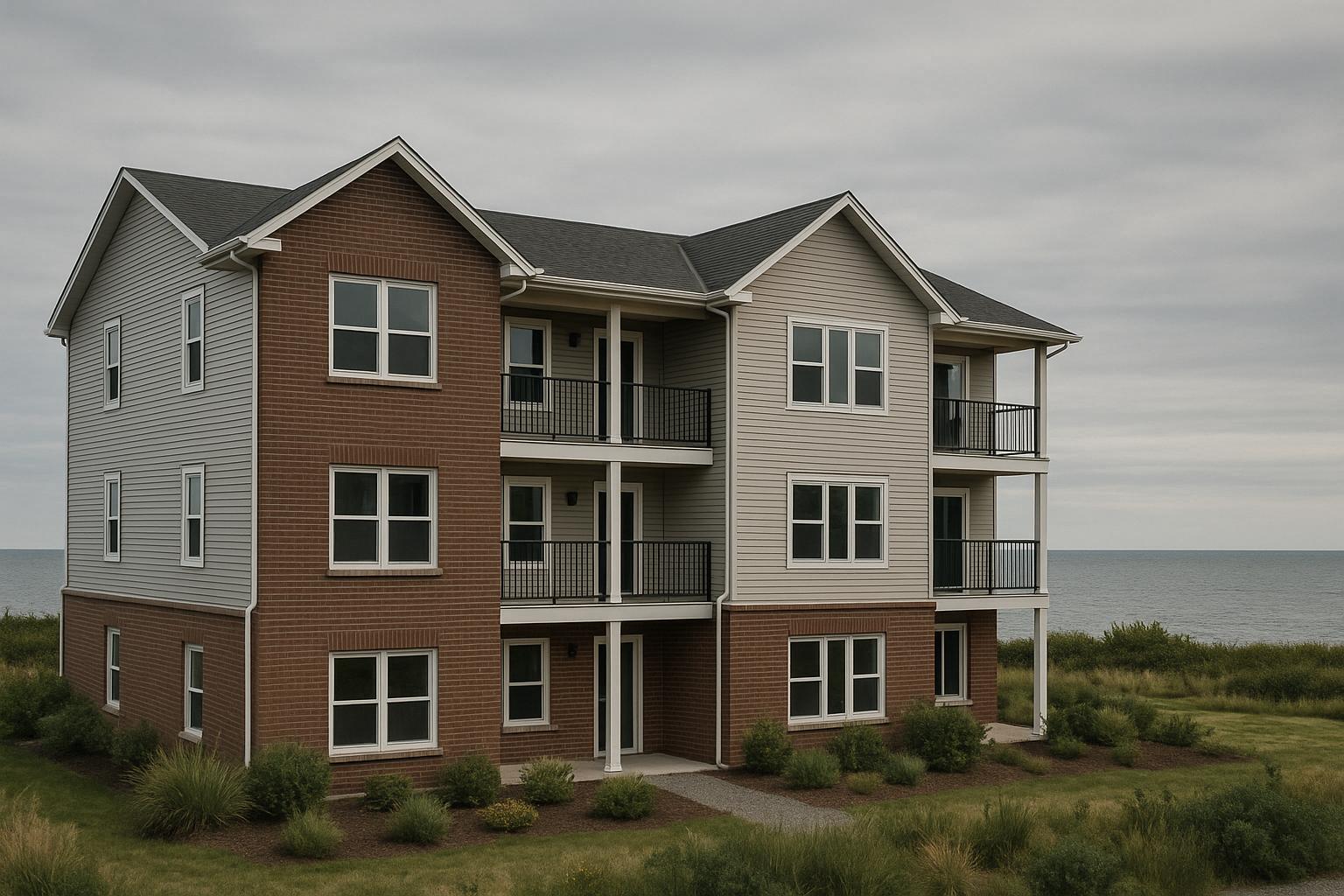Halifax's ER-3 zoning allows small lot owners to build multi-unit rentals, but it comes with strict rules and challenges. Here’s how you can maximize space and stay compliant:
- Height Limit: 11 m, with an extra 3 m for pitched roofs, offering more usable upper-floor space.
- Density Control: No fixed unit cap, but Floor Area Ratio (FAR) and setbacks indirectly limit unit size and number.
- Parking & Setbacks: Lot coverage and parking requirements reduce buildable space. Underground parking can help.
- Heritage Rules: Extra regulations apply in Heritage Conservation Districts, requiring designs to match the area’s character.
Key Design Tips:
- Use vertical layouts to maximize the height allowance.
- Leverage roof space for lofts or storage.
- Exemptions like amenity space and specific corridor designs increase usable floor area.
- Efficient placement of mechanical systems saves space.
Construction Options:
Using a single integrated builder simplifies the process, cuts costs by about $47,000, and prevents delays that could cost $8,800/month in lost rental income. Fixed-price contracts provide cost certainty, avoiding 30–60% overruns common with cost-plus pricing.
Permits & Stormwater:
Proper stormwater management is mandatory in Halifax. Use rain gardens, barrels, or permeable materials to meet regulations and avoid delays.
ER-3 Zoning Rules: What You Can and Cannot Build
ER-3 zoning in Halifax opens the door to multi-unit developments, but understanding the regulations is crucial. These rules impact essential aspects like building height, unit density, and site layout, all of which play a significant role in shaping your project.
Height Limits and Unit Density
For buildings in ER-3 zones, the height is typically capped at 11 metres, measured from the average grade to the roof's highest point. However, an additional 3 metres is allowed for pitched roofs, which can create more usable space on the upper level and add flexibility to your design. While there’s no strict limit on the number of units, the density is indirectly controlled by the floor area ratio (FAR) and other site-specific factors. Using the extra roof height effectively can help optimize the number of units within these constraints.
Lot Coverage, Setbacks, and Parking Considerations
Key elements like lot coverage, setbacks, and parking requirements significantly influence how much of the property can be developed. These rules dictate the portion of the land that can be built on and where structures can be positioned, often limiting the usable space. It's essential to consult local municipal guidelines to ensure compliance. If surface space is limited, solutions like underground parking can help maximize the lot’s potential while meeting parking requirements.
Heritage District Regulations
If your property is located in a Heritage Conservation District, additional rules apply on top of standard ER-3 zoning regulations. For instance, in the Schmidtville Heritage Conservation District, the HCD-SV zone maintains the residential focus of ER-3 while allowing limited local commercial activities[1]. Developments in these areas must adhere to both general land-use rules and specific heritage by-laws[1]. This dual framework requires careful planning to ensure your design aligns with the historic character of the neighbourhood. For properties in proposed Heritage Conservation Districts, developers should consult Map 20 and detailed fact sheets available on centreplan.ca for further guidance[2].
Design Methods to Fit More Units on Small Lots
Making the most of limited space on small lots requires clever design strategies. By focusing on vertical space and leveraging design exemptions, you can create functional, efficient layouts that adhere to ER-3 zoning rules.
Building Up: Stacked Unit Layouts
Vertical layouts are key to maximizing the 11-metre height allowance. Smart use of floor area exemptions can significantly increase usable space without exceeding Floor Area Ratio (FAR) limits. For example, up to 5% of the residential floor area can be allocated to amenities like recreation rooms, co-working spaces, libraries, music practice areas, package storage, laundry facilities, or pet-friendly zones - none of which count toward the total floor area calculation [3].
Corridor design can also contribute to exemptions. Corridors with direct balcony access, at least 20 square feet of glazing, or those extending no more than 100 linear feet from the vertical core qualify for a 50% floor area exemption [3]. Additionally, refuse storage can be excluded from calculations, allowing a deduction of up to three square feet per dwelling unit [3].
To further expand usable space, consider utilizing roof areas creatively.
Using the 3 m Pitched Roof Space
The extra 3 metres of height permitted for pitched roofs is a game-changer for small-lot developments. This space can be transformed into loft-style bedrooms, storage, or compact living areas, boosting the property's rental or functional value.
For curb-level entries leading to elevated units, you can exempt up to 100 square feet per foot of elevation difference, with a maximum of 500 square feet [3]. Outdoor features like unenclosed balconies and open terraces add value for residents without affecting floor area calculations. These elements are allowed as obstructions in yards, though they must adhere to placement restrictions, such as avoiding side yards or being within five feet of side or rear lot lines in rear yards [3].
By combining vertical expansion with efficient roof design, you can make the most of the available space.
Space-Saving Floor Plans and Mechanical Systems
Efficient placement of mechanical systems is another way to free up livable space. Systems like HVAC units and solar panels can be positioned as permitted obstructions, saving valuable room. Solar panels, for instance, can extend up to 18 inches above other roof obstructions without violating height restrictions [3].
For single- or two-family homes, overhanging portions above the first storey can project up to three feet into the front yard, as long as the lowest part of the projection is at least seven feet above the yard level. This creates opportunities for covered entrances or additional interior space on upper floors [3].
Getting Permits and Meeting Code Requirements
When working on Halifax ER-3 projects, managing stormwater effectively is a key step to avoid permit delays, control runoff, and maintain water quality. These efforts go hand in hand with the design strategies already mentioned, ensuring your project complies with both spatial and regulatory standards.
Stormwater Management and Site Conditions
In Halifax, stormwater cannot be directed into the wastewater system, as per Halifax Water regulations. This means careful planning is required to manage runoff properly. Well-thought-out stormwater solutions not only help with the permit process but also align with an integrated design approach. Property owners are responsible for maintaining private systems like downspouts, footing drains, and area drains.
Urban development often leads to more impervious surfaces, which can increase runoff, degrade water quality, and contribute to flooding. To combat these issues, designs should focus on keeping rainwater close to where it falls, allowing it to soak into the ground. Here are a few practical strategies:
- Add rain gardens to absorb runoff naturally.
- Use rain barrels to collect and repurpose rainwater, but disconnect them during the winter months.
- Opt for pervious materials like permeable pavers to reduce runoff.
- Install swales or vegetated filter strips to guide and manage water flow.
- Plant trees strategically - avoiding areas with underground systems - to improve water absorption.
Public stormwater infrastructure, such as ditches, culverts, catch basins, and retention ponds, is managed by Halifax Water. Meanwhile, the municipality takes care of roadway shoulders and curb maintenance [4].
sbb-itb-16b8a48
Single-Contract Construction vs. Multiple Contractors
When building multi-unit rental properties on small ER-3 lots in Halifax, property owners face a pivotal decision: should they hire multiple contractors for different phases or rely on a single integrated company? This choice has a direct impact on costs, timelines, and overall project stress.
One Company vs. Multiple Contractors
Traditional construction often involves juggling multiple specialized professionals: planners, architects, engineers, general contractors, specialty trades, and project managers. Each operates independently, with their own priorities, timelines, and methods of communication.
This fragmented setup can lead to communication breakdowns. For instance, if an architect’s design doesn’t align with an engineer’s specifications or if a contractor uncovers an issue that wasn’t addressed during planning, delays ripple through the project. Property owners are left coordinating between professionals, which not only slows progress but also adds unexpected costs.
The financial toll is no small matter. On average, $47,000 is wasted on multi-unit projects due to miscommunication, delays, and rework caused by poor coordination. When problems arise, blame is often passed around - architects point fingers at engineers, contractors blame architects, and, ultimately, property owners bear the financial burden of these mistakes.
Integrated design-build companies solve these issues by housing all professionals under one roof. From the start, design, engineering, and construction teams work together, sharing the same goals and timeline. Any issues that arise are addressed internally, without affecting the property owner’s budget or schedule. This streamlined approach not only simplifies coordination but also ensures more predictable pricing.
Fixed Price vs. Cost-Plus Contracts
Another key consideration is the type of contract: fixed price or cost-plus.
Traditional contractors often use cost-plus pricing, where property owners pay for materials, labour, and overhead, plus a markup. In this model, the property owner assumes all financial risk. If lumber prices rise, permits are delayed, or design changes add work, the property owner absorbs these extra costs.
Cost-plus contracts can result in significant overruns - often by 30–60%. A project initially estimated at $600,000 can easily climb to $800,000 or more. Worse, these overruns often come to light too late for property owners to make adjustments.
Fixed-price contracts, on the other hand, offer complete cost certainty before construction begins. The price is locked in, shielding property owners from unexpected spikes in material costs, labour increases, or unforeseen changes. If unexpected issues arise, the builder absorbs the costs rather than passing them along.
This pricing model requires builders to excel at estimating, planning, and executing projects. Only those confident in their processes and systems can offer true fixed-price contracts with meaningful financial guarantees.
Timeline Guarantees and Quality Control
Beyond cost control, a unified construction process also improves timelines and quality. Multi-unit projects typically take 12–18 months, and delays can be costly for property owners.
The financial impact of delays is clear. Every month of delay costs $8,800 in lost rental income for a fourplex generating $2,200 per unit monthly. A six-month delay translates to $52,800 in lost revenue - money that can never be recovered.
Integrated builders with advanced scheduling systems can guarantee six-month construction timelines and even include financial penalties for delays. Some companies offer up to $1,000 per day in penalties if they miss deadlines, ensuring their motivation aligns with the property owner’s.
Quality control is another advantage of single-contract construction. Instead of relying on multiple contractors to maintain consistent standards, integrated builders use systematic quality verification processes. Professional engineers conduct inspections throughout the build, and property owners can bring in their own final inspector for added assurance. This consolidated approach ensures that cost, timeline, and quality risks are all managed under one roof.
Additionally, two-year warranties on all construction work provide long-term peace of mind. Unlike working with multiple contractors - where warranty issues can lead to finger-pointing - integrated builders take full responsibility for any problems that arise.
Transparency is yet another benefit. With features like daily photo updates and real-time project portals, property owners stay informed without needing to make constant site visits or juggle communication with multiple contractors.
Summary: Building More Units on Small ER-3 Lots
To make the most of small ER-3 lots in Halifax, property owners need to focus on zoning rules, smart design, and efficient construction methods. Those who understand these elements can turn even limited urban spaces into profitable rental properties.
The zoning rules allow for an 11-metre height limit, with an additional 3 metres for a pitched roof. This makes multi-storey buildings a practical choice, enabling more units to fit within the required setbacks and lot coverage. Designing upward rather than outward, along with using stacked layouts and maximizing roof space, can significantly increase unit capacity and rental income.
Every square metre counts on a small lot. Thoughtful floor plans, strategic placement of mechanical systems, and meeting parking requirements without sacrificing liveable space are critical for attracting quality tenants and achieving higher rents.
Traditional construction methods, which rely on multiple contractors, often lead to budget overruns of 30–60% and delays that could cost property owners around CA$8,000 monthly in lost rental income. On the other hand, integrated design-build companies simplify the process by managing everything under one roof. This approach typically saves property owners about CA$47,000 by reducing coordination inefficiencies. It also offers fixed-price contracts with guaranteed timelines and penalties for delays - up to CA$1,000 per day - making the process smoother and more predictable.
For financing, the CMHC MLI Select program provides up to 95% financing at CA$200,000 per unit, repayable over 50 years. This can help property owners achieve positive cash flow from the start.
FAQs
How can property owners make the most of the extra 3 metres allowed for pitched roofs in ER-3 zoning?
Property owners can make the most of the extra 3 metres allowed for pitched roofs by designing rooflines that hit the 11-metre height limit while staying within zoning rules. This clever use of space can open up opportunities for functional attic or upper-level areas - an especially smart move for smaller lots where every square metre matters.
With thoughtful planning of sloped roof designs, you can expand interior volume without breaking zoning restrictions. This approach not only maximizes usable space but also creates room for more efficient multi-unit layouts. For compact urban properties, this can lead to better rental income potential and an overall boost in property value.
What are the advantages of using a single integrated builder for multi-unit rentals on small lots?
Choosing a single integrated builder simplifies the construction process from start to finish. By keeping everything under one roof, you minimize miscommunication, avoid unnecessary delays, and keep unexpected costs in check. This approach ensures everything runs more smoothly, leading to quicker project completion, better-quality builds, and tighter cost management.
Working with an integrated builder can also cut overall project costs by as much as 25%. How? By eliminating inefficiencies and offering a clear, fixed-price structure. This not only reduces surprises but also increases accountability, making it easier to build profitable rental properties on smaller lots without the usual headaches.
What are the best stormwater management practices to meet Halifax regulations and avoid delays during construction?
To comply with Halifax's stormwater regulations and avoid construction delays, careful planning and smart on-site management are key. One practical step is to redirect roof drains, sump pumps, and foundation drains to landscaped areas. This approach allows runoff to be absorbed naturally, reducing its impact.
Another important measure is creating a Stormwater Management Plan. By leveraging the site’s natural topography and incorporating features like rain gardens or permeable surfaces, you can effectively manage water flow.
These strategies not only help meet regulatory requirements but also simplify the approval process, keeping your project on track. Taking a proactive approach to stormwater management can cut costs, save time, and promote environmentally responsible urban development.



